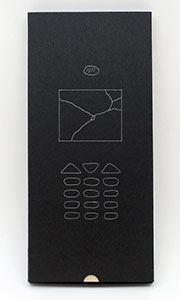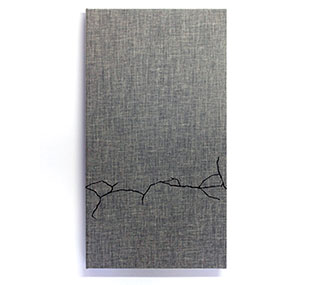|
Jillian M. Sico ~ Colorado
(Frogsong Press)
|
Share this page: |
| |
|
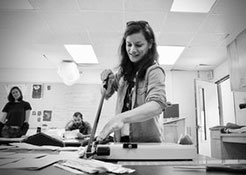 |
Frogsong Press: " Jillian Sico is a printer, papermaker, and bookbinder pursuing an MFA in Book Arts at the University of Alabama. She received her BA from St. John’s College in Annapolis, MD in 2005 and her MA in Anthropology from the University of Georgia in 2013. Jillian lives in Tuscaloosa, Alabama and prints artist books under the name Frogsong Press." Artist Statement: "My work is inspired by the slow, quiet reality encountered in wild places and natural processes. My content is influenced by philosophical, scientific, and religious texts that explore the visible and invisible layers of meaning embedded in natural systems. In-depth, on-site research, especially related to ecology and papermaking traditions, is a key part of my process." |
| |
|
Vines, A Looming Is, We Sent It to the Moon
By Jillian M. Sico
Tuscaloosa, AL: Frogsong Press, 2019. Edition of 20.
Size: 4 x 9” in paper box with band type slipcase. Colophon tipped in bottom of box. Contains three pamphlets. Letterpress printed. Materials: Hahnemuhle Ingres paper; kozo paper; handmade wisteria and kozo paper; handmade cotton/flax paper; thread. Signed and numbered by the artists.
Frogsong Press: "’Vines’, ‘A Looming Is’, & ‘We Sent it to the Moon’ is a collection of three letterpress-printed books that represent a collaboration between Alexa Tullett, Sarah Scarr, and Jillian Sico (respectively). Each book presents a unique perspective on the present and future of electronic and digital waste. The three books are housed in a box designed to look like a 1990s-era cell phone.
“’Vines’, written by Alexa Tullett, is a humorous textual ‘archive’ of six-second video clips that were uploaded to the now-defunct social media service Vine. The descriptions are accompanied by images of cell phones being overtaken by kudzu vines, with a cover of wisteria & kozo paper.
“’ A Looming Is’ is a prose poem by Sarah Scarr about ‘trash’ satellites that orbit the earth, with eerie depictions of contemporary modes of communication.
“’We Sent it to the Moon’ envisions an ironically optimistic future in which e-waste is shipped to the moon, with images created using a scratch-negative technique."
$300 |
|
| |
|
| |
|
|
| Jillian M. Sico SOLD / Out of Print Titles: |
|
| |
|
House of Bones
By Jillian M. Sico
Tuscaloosa, AL: Frogsong Press, 2018. Edition of 22.
4 x 6"; 24 pages. Printed letterpress on Rives heavy weight paper. Bound in handmade cotton paper. Woodcut images. Signed and numbered by the artist.
Jillian M. Sico: " 'House of Bones' is a letterpress-printed artist book that uses woodcut images to illustrate an original poem about the natural cycles of life and death, inspired by a verse from the Buddhist Dhammapada. The images are paired with type handset in Bembo. The cover is handmade cotton paper with grass inclusions, echoing a refrain from the poem: 'the grass grows tall'.”
(SOLD/Out of Print) |
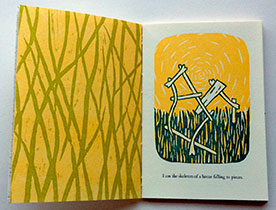
Click image for more |
| |
|
Mycorrhizae
By Jillian M. Sico
Tuscaloosa, AL: Frogsong Press, 2020. Edition of 22.
5.5 x 10.75" sectioned clamshell box containing two pamphlets. Colophon tipped into interior top and base. Letterpress-printed on a Vandercook #4 press at the University of Alabama. Baskerville type. Images based on root scans and mycelium imagery, printed from photopolymer plates. Forest scene printed from wood veneer. Text and images by Jillian Sico. Informational pamphlet text by Katie Beidler. Materials: Linen/flax paper with charcoal, tree-retted linen paper, bleached flax paper, Alabama kozo paper with watermarks, recycled paper with chanterelle mushroom spores, recycled paper with polypore mushrooms, thread, board, Duo bookcloth. Signed and numbered by Sico.
Jillian M. Sico: "Mycorrhizae explores connectivity and loss from a personal and ecological perspective through an examination of mycorrhizal fungi. Mycorrhizae are necessary symbiotic associations between fungi and plant roots. Mycorrhizal fungi uptake and distribute essential nutrients to plants, store carbon in the soil, and help communicate information among and between plant species.
"Research for this project took place in the Cohutta Wilderness and Wildlife Management Area in the mountains of North Georgia. Throughout the course of the project, personal reflections on love and loss became intertwined with research about mycorrhizae and the history of the forest. I knew that I was documenting only a moment in time: this place as I knew and remembered it would one day be gone. North Georgia was logged extensively from the 1880s through the 1950s, leaving only 2% of its original old-growth forest. In October 2016, the catastrophic Rough Ridge wildfire burned almost 28,000 acres in the Cohutta Wilderness. Other disruptions, such as disease and invasive pests, continue to alter the forest landscape, including the hidden, underground landscape that sustains it. But although we may lose a place, we can adjust and form new connections while still earnestly mourning the loss of what was.
"I used papermaking as a performative medium to tie the book materially to a specific place and time. I formed sheets from linen fibers that had been buried at the base of a tulip poplar tree in the Cohutta, intertwining with mycelium, fine roots, insects, and worms, and drew organic patterns in the pulp with charcoal harvested from the same tree. I created watermarks based on images of mycelium I saw in soil samples under a microscope, scanned tree roots, and poured jugs of mushroom spores into paper pulp. The sound and texture of the finished paper, along with reflective text and images, recreate for the reader the experience of genuine connection with the forest.
"Mycorrhizae is a collaboration that includes a personal, reflective text by the author and an accompanying informational text by ecologist Katie Beidler. The collaboration highlights both the personal, specific and scientific, universal aspects of mycorrhizal connections in a forest ecosystem."
(SOLD/Out of Print) |
|
| |
|
Mycorrhizae: The Other Half of the Hidden Half
By Jillian M. Sico; Kate Beidler
Tuscaloosa, AL: Frogsong Press, 2020. Edition of 62.
8 x 4.4"; 16 pages. Handmade paper. Sewn pamphlet binding. Signed and numbered by Sico.
Jillian M. Sico: "'An informational pamphlet, 'Mycorrhizae: the other half of the hidden half', written by ecologist Katie Beidler. Mycorrhizae are underground, necessary symbiotic associations between fungi and plant roots that facilitate nutrient exchange and help communicate information among and between plant species. Robust mycorrhizal systems are a marker of the health of an established forest ecosystem and play a key role in soil carbon storage. Beidler's informative text provides an overview of mycorrhizae and their function within ecosystems, accompanied by scans of several species of tree roots.
"This book was letterpress printed on handmade paper as part of an artist book project entitled ‘Mycorrhizae’. I printed 62 of these pamphlet books on 100% handmade recycled paper with polypore mushroom inclusions. All of the paper is inoculated with chanterelle mushroom spores.
"The images are based on root scans and mycelium imagery printed from photopolymer plates. I made all of the paper for the edition by hand in the Lost Arch Paper Mill at The University of Alabama and outdoors in Tuscaloosa, Alabama."
(SOLD/Out of Print) |
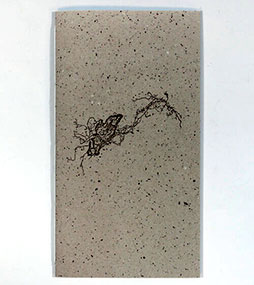
Click image for more |
| |
|
Tribute
By Jillian M. Sico
Tuscaloosa, AL: Frogsong Press, 2018.
Edition of 14+ Special Edition of 2.
8.25 x 4" with accordion structure. Materials: Handmade kozo bark paper, handmade kozo, Zerkall book paper, photopolymer prints. Bound in bark paper made with Alabama kozo. Laid in cloth covered clam shell box .Signed and numbered by the artist. Designed, printed, and bound by the artist at the University of Alabama.
Jillian M. Sico: "'Tribute' is a letterpress-printed artist book that explores the history of amate papermaking in Mexico. The text is inspired by the 1542 Aztec Codex Mendoza and my experience making amate in San Pablito, Mexico. For the cover, I made my own Alabama kozo bark paper using methods I learned in San Pablito."
Colophon: "San Pablito is the only place where traditional amate, a bark paper pounded with volcanic stone, is still made today.
"The text is inspired by the Codex Mendoza, a 1541 book with prehispanic-style Nahuatl pictograms with a Spanish gloss. It lists Aztec conquests and tributes demanded from surrounding areas. The back of 'Tribute' shows towns still existing in Mexico today where amate was once made. "Prehispanic screenfold books, most of which were burned by the Spanish, were often painted on amate. Some contained mnemonics for recitation of poetry."
(SOLD/Out of Print) |
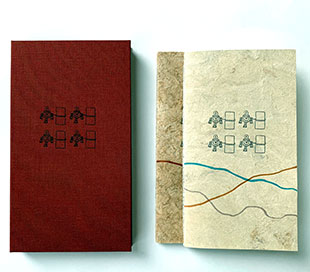
Click image for more |
| |
|
| |
|
Page last update: 03.20.2025
|


